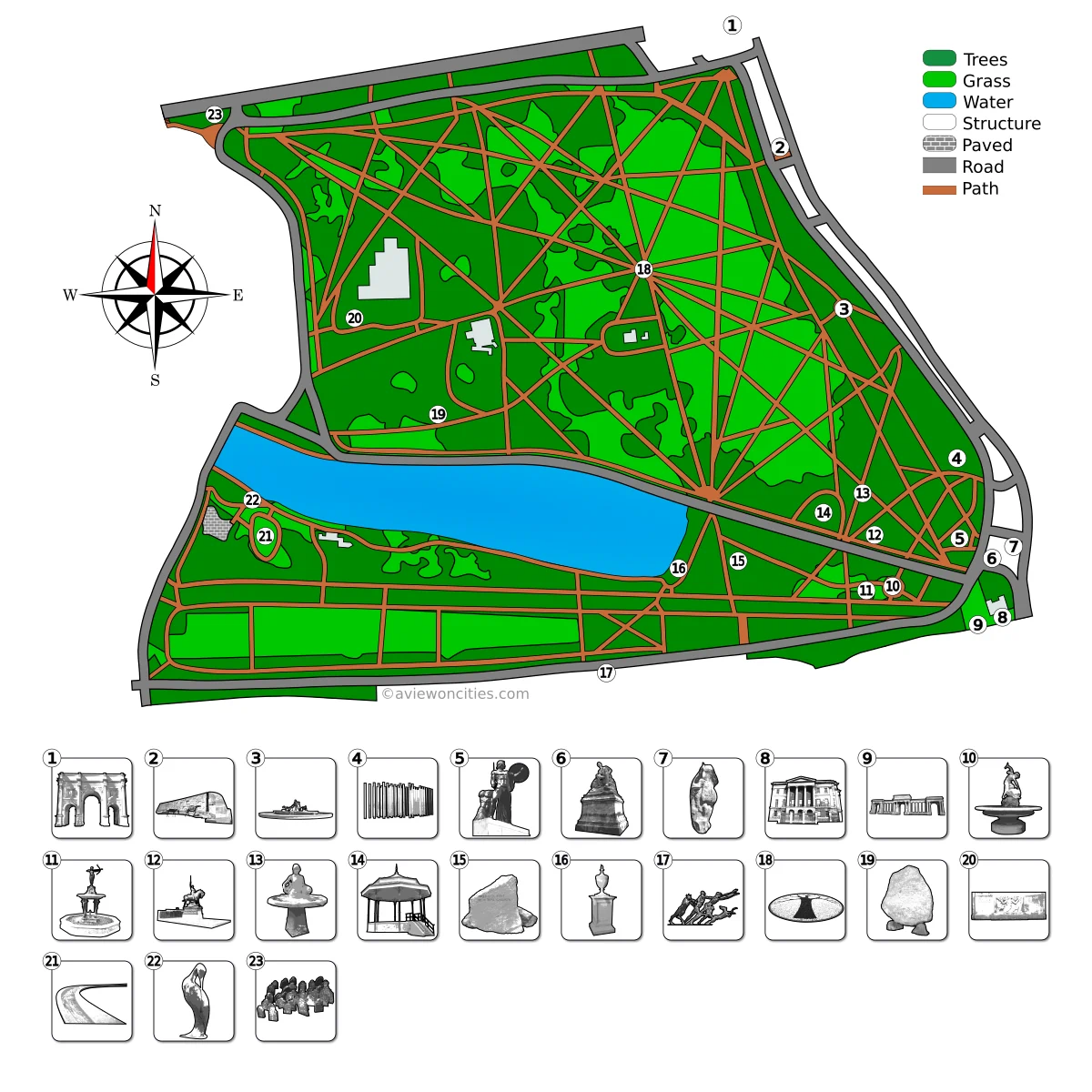Hyde Park is the largest of the four royal parks in central London that are connected to each other, forming one large green lung in the heart of the city.
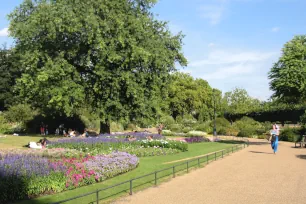
The other parks are the adjoining Kensington Gardens, Green Park and St. James’s Park. Hyde Park covers more than 360 acres (142 hectares) and hosts many large events, including celebrations and concerts. It is also a popular place for jogging, swimming, rowing, picnicking and even horse riding. Hyde Park is home to over twenty monuments and memorials, but it might be best known for its Speakers’ Corner: an area in the northeast corner of the park where free speech, open-air public speaking, debate, and discussion are allowed.
History
Hunting grounds
In 1536 King Henry VIII confiscated Hyde Park from the monks of Westminster Abbey and used it as a private hunting ground. King Charles I opened the park to the public in 1637. The park was redesigned in 1726, first on order of King George I and later under the direction of Caroline of Ansbach, Queen Consort to George II. She split off Kensington Gardens from Hyde Park and added the large lake.
Crystal Palace
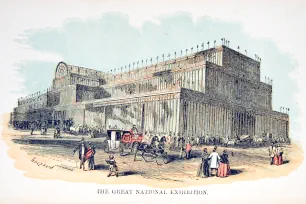
In 1851 Crystal Palace was built on the south side of the park. The magnificent glass-and iron structure was designed by Joseph Paxton to house the Great Exhibition of 1851. Despite its enormous dimensions – it measured 564 meters long and 39 meters in height (1851 x 128 feet) – construction took less than a year. After the exhibition closed, the building was relocated out of the park, since the public did not want the enormous structure to stay in Hyde Park.
Decimus Burton’s plan
The park as we know it today was planned in 1825 by the young architect Decimus Burton, who, on the order of King George IV, rejuvenated the then-neglected park by adding new paths and vistas, as well as installing a new enclosure around the park in which he built several gates, the most famous of which is Apsley Gate ![]() , also known as Hyde Park Screen. He was also responsible for the monumental Wellington Arch on Hyde Park Corner, on the southeast edge of the park.
, also known as Hyde Park Screen. He was also responsible for the monumental Wellington Arch on Hyde Park Corner, on the southeast edge of the park.
Sights
Hyde Park boasts plenty of monuments, memorials and other sights, and you can easily spend several hours exploring the park.
Serpentine
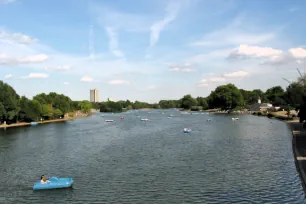
The Serpentine, a large artificial lake, is located at the south end of the park and extends northwards into the neighboring Kensington Gardens, where it is called Long Water. Queen Caroline, wife of King George II, had the lake constructed in 1730. It is popular for boating and swimming. The Serpentine, a large artificial lake, is located at the south end of the park and extends northwards into the neighboring Kensington Gardens, where it is called Long Water. Queen Caroline, consort of King George II, had the lake constructed between 1727 and 1731. It is popular for boating and swimming. On the east bank of the lake is a small memorial to Queen Caroline ![]() . The memorial in the shape of an urn was unveiled here in 1990 by Queen Elisabeth II.
. The memorial in the shape of an urn was unveiled here in 1990 by Queen Elisabeth II.
Rotten Row
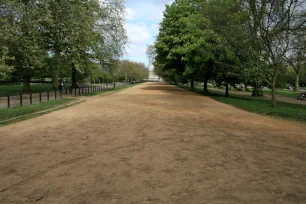
South of the Serpentine lies Rotten Row, a famous bridle path. The road is almost four miles long (6.4 km) and is now used as a horse riding and jogging route.
In the seventeenth century, the road was often used by William III. The king found the walk from Kensington Palace to St. James’s Palace too dangerous, so he had oil lamps installed along the route, thus creating the first lit public road in England. The term ‘Rotten Row’ is derived from the French “route du roi” or King’s road.
Speakers’ Corner
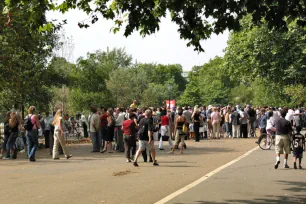
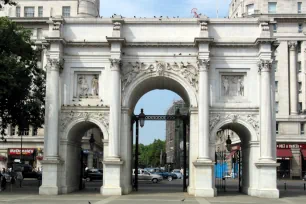
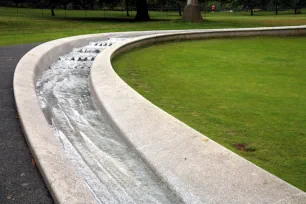
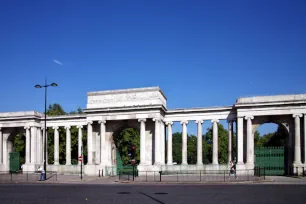
In the nineteenth century, Hyde Park had become a popular place for meetings. In 1872, in response to riots that erupted after police tried to disband a political meeting, Speakers’ Corner was established to create a venue where people would be allowed to speak freely. Here, every Sunday people stand on a soap box and proclaim their views on political, religious or other items, sometimes interrupted and challenged by their audience.
Marble Arch
Near Speakers’ Corner stands Marble Arch ![]() , one of the most impressive monuments in Hyde Park, although it is technically just outside the park, on a traffic island near its northernmost point. The arch was originally built in 1827 as a gateway to Buckingham Palace, but it was moved to its present location in 1851. The design by John Nash was based on the Arch of Constantine in Rome. The upper part of the arch was once in use as a tiny police station. To the west of the Marble arch, on another traffic island, is a series of fountains, installed here in 1961.
, one of the most impressive monuments in Hyde Park, although it is technically just outside the park, on a traffic island near its northernmost point. The arch was originally built in 1827 as a gateway to Buckingham Palace, but it was moved to its present location in 1851. The design by John Nash was based on the Arch of Constantine in Rome. The upper part of the arch was once in use as a tiny police station. To the west of the Marble arch, on another traffic island, is a series of fountains, installed here in 1961.
Diana, Princess of Wales Memorial Fountain
Just south of the Serpentine is the Diana, Princess of Wales Memorial Fountain ![]() , a memorial installed in honor of princess Diana. The modern fountain, which more resembles an artificial stream rather than a fountain, was inaugurated in 2004 by Queen Elizabeth II.
, a memorial installed in honor of princess Diana. The modern fountain, which more resembles an artificial stream rather than a fountain, was inaugurated in 2004 by Queen Elizabeth II.
The memorial was designed by the American landscape architect Kathryn Gustafson, using computer modeling techniques. The circular fountain consists of 545 pieces of Cornish granite. Water flows from two sides at the top into a small pool at the bottom.
Apsley House and Gate
In the southeast corner of Hyde Park, near Hyde Park Corner, stands Apsley House ![]() , once the residence of Arthur Wellesley, the first Duke of Wellington, who is best known as the victor over Napoleon’s army at Waterloo. The house was originally built between 1771 and 1778 for Lord Apsley. Today it is home to the Wellington Museum.
, once the residence of Arthur Wellesley, the first Duke of Wellington, who is best known as the victor over Napoleon’s army at Waterloo. The house was originally built between 1771 and 1778 for Lord Apsley. Today it is home to the Wellington Museum.
Right next to Apsley House is Apsley Gate ![]() , also known as Hyde Park Screen. It is a large stone screen that was built in 1825 by Decimus Burton as a triple-arched gateway to Hyde Park. The friezes were copied from the Elgin Marbles that were originally on the Parthenon.
, also known as Hyde Park Screen. It is a large stone screen that was built in 1825 by Decimus Burton as a triple-arched gateway to Hyde Park. The friezes were copied from the Elgin Marbles that were originally on the Parthenon.
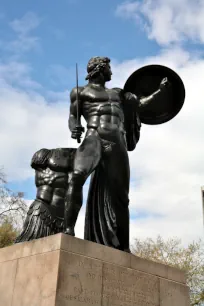
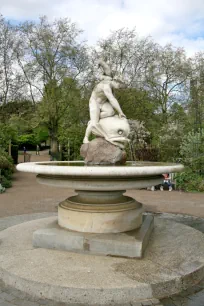
Achilles Statue
Just north of Apsley Gate is the Achilles Statue ![]() , which was installed in 1822 to honor the Duke of Wellington. The bronze statue was cast from cannons that were captured from the French at Vittoria, Salamanca, Waterloo and Toulouse. The statue was created by Richard Westmacott, who based its design on the statues of Castor and Pollux on Piazza del Quirinale in Rome. The statue was originally nude but true to their reputation, the prudish Londoners were shocked and Westmacott was forced to add a fig leaf, hence the rather ridiculous appearance of the statue.
, which was installed in 1822 to honor the Duke of Wellington. The bronze statue was cast from cannons that were captured from the French at Vittoria, Salamanca, Waterloo and Toulouse. The statue was created by Richard Westmacott, who based its design on the statues of Castor and Pollux on Piazza del Quirinale in Rome. The statue was originally nude but true to their reputation, the prudish Londoners were shocked and Westmacott was forced to add a fig leaf, hence the rather ridiculous appearance of the statue.
The Rose Garden
Most of the park consists of open grassy areas dotted with large trees. There are very few flowerbeds or shrubs, but one exception is the beautiful rose garden in the southeast corner of Hyde Park.
Here you find plenty of flowers, a long winding pergola and two fine fountains. The oldest of the two is the Artemis Fountain, also known as the Huntress fountain ![]() , which shows the Greek goddess of the Hunt Artemis (who is better known by her Roman name Diana). The fountain was created in 1822 by Richard Westmacott, the sculptor of the nearby Achilles Statue.
, which shows the Greek goddess of the Hunt Artemis (who is better known by her Roman name Diana). The fountain was created in 1822 by Richard Westmacott, the sculptor of the nearby Achilles Statue.
The other fountain in the Rose Garden is known as the Boy and Dolphin Fountain ![]() . It was created in 1862 by Alexander Munro and was originally placed in a sunken Victorian garden. In 1995 the fountain was moved to its current location.
. It was created in 1862 by Alexander Munro and was originally placed in a sunken Victorian garden. In 1995 the fountain was moved to its current location.
Joy of Life Fountain
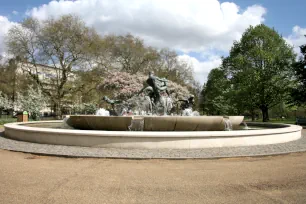
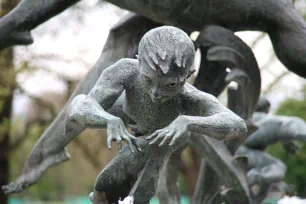
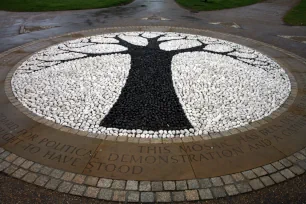
The largest fountain in Hyde Park and arguably the most intriguing one is the Joy of Life Fountain ![]() . The fountain is decorated with bronze sculptures that float over a large circular basin. At the center are two adults, seemingly dancing and holding each other’s arms. Around them are four statues of children who seem to hover over the water. The fountain, a work of sculptor Thomas Bayliss Huxley-Jones, was created in 1963. It is sometimes also called the Four Winds Fountain.
. The fountain is decorated with bronze sculptures that float over a large circular basin. At the center are two adults, seemingly dancing and holding each other’s arms. Around them are four statues of children who seem to hover over the water. The fountain, a work of sculptor Thomas Bayliss Huxley-Jones, was created in 1963. It is sometimes also called the Four Winds Fountain.
More sights in and around Hyde Park
There are several more memorials and statues in Hyde Park. One of the largest is the 7/7 Memorial ![]() , which commemorates the victims of the terrorist attack of July 7, 2005. The monument consists of fifty-two stainless steel columns; each one represents one of the victims of the bombings.
, which commemorates the victims of the terrorist attack of July 7, 2005. The monument consists of fifty-two stainless steel columns; each one represents one of the victims of the bombings.
A very different memorial is the Reformers’ Tree ![]() , a circular black and white mosaic laid out in 2001. The mosaic marks the spot of an oak that was burned down during the riots of 1866. The charred stump was used as a notice board for political manifestations organized by the Reform League. The manifestations would lead to the creation of the nearby Speakers’ Corner.
, a circular black and white mosaic laid out in 2001. The mosaic marks the spot of an oak that was burned down during the riots of 1866. The charred stump was used as a notice board for political manifestations organized by the Reform League. The manifestations would lead to the creation of the nearby Speakers’ Corner.
A more conventional memorial honors William Henry Hudson ![]() , a writer and naturalist. The monument, a relief created by Jacob Epstein, was quite controversial when it was unveiled in 1925, but today it’s hard to see why.
, a writer and naturalist. The monument, a relief created by Jacob Epstein, was quite controversial when it was unveiled in 1925, but today it’s hard to see why.
To the south of the W.H. Hudson Memorial, just north of the Serpentine, is the Norwegian War Memorial ![]() . The large boulder supported by three smaller stones was presented in 1978 by the Norwegian Navy and Merchant Fleet as thanks for British support during the Second World War.
. The large boulder supported by three smaller stones was presented in 1978 by the Norwegian Navy and Merchant Fleet as thanks for British support during the Second World War.
There are more boulder-shaped memorials in Hyde Park: the Holocaust Memorial ![]() , situated west of the Rose Garden, is a garden of boulders. It was the first memorial to the victims of the Holocaust in Britain.
, situated west of the Rose Garden, is a garden of boulders. It was the first memorial to the victims of the Holocaust in Britain.
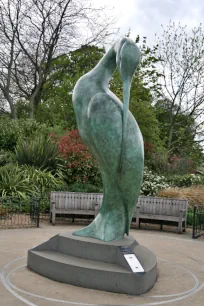
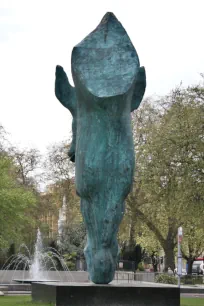
The Cavalry Memorial ![]() , which features statues of St. George and a dragon, was unveiled in 1924 and commemorates the Cavalry regiments that served in the World Wars.
, which features statues of St. George and a dragon, was unveiled in 1924 and commemorates the Cavalry regiments that served in the World Wars.
Nearby is the Mermaid Fountain ![]() , a small fountain that was originally created in 1896 by the British Sculptor William Robert Colton. Unfortunately it was replaced in 1974 by a dissappointing concrete replica. The female figure on the fountain is known as Little Nell.
, a small fountain that was originally created in 1896 by the British Sculptor William Robert Colton. Unfortunately it was replaced in 1974 by a dissappointing concrete replica. The female figure on the fountain is known as Little Nell.
Just west of Little Nell stands Hyde Park’s bandstand ![]() . It was built in 1890 making it one of the oldest bandstands in Britain. Even to this day the octagonal bandstand is used for concerts during summer.
. It was built in 1890 making it one of the oldest bandstands in Britain. Even to this day the octagonal bandstand is used for concerts during summer.
A more modern monument is Serenity ![]() , a three-meter-tall statue of an ibis created by British sculptor Simon Gudgeon. The statue was installed in 2009 near the Serpentine. It was originally named Isis after the Egyptian goddess of motherhood and patroness of nature and magic, but was renamed in 2015.
, a three-meter-tall statue of an ibis created by British sculptor Simon Gudgeon. The statue was installed in 2009 near the Serpentine. It was originally named Isis after the Egyptian goddess of motherhood and patroness of nature and magic, but was renamed in 2015.
Another modern sight is called Still Water ![]() . It can be found on a traffic island between the dual carriageways of Park Lane Road, just north of Apsley House, just outside the boundaries of Hyde Park. The statue shows a huge head of a horse, over ten meters tall (about 35 ft). The bronze statue, created by the British sculptor Nic Fiddian-Green, was unveiled in 2009.
. It can be found on a traffic island between the dual carriageways of Park Lane Road, just north of Apsley House, just outside the boundaries of Hyde Park. The statue shows a huge head of a horse, over ten meters tall (about 35 ft). The bronze statue, created by the British sculptor Nic Fiddian-Green, was unveiled in 2009.
On the same traffic island is a monument to the poet Byron ![]() , who is shown seated with his faithful Landseer dog Boatswain by his side. The statue was created in 1880 by Richard C. Belt and rests on an enormous marble plinth.
, who is shown seated with his faithful Landseer dog Boatswain by his side. The statue was created in 1880 by Richard C. Belt and rests on an enormous marble plinth.
There’s a third monument between the traffic-infested roads of Park Lane: the Animals in War memorial ![]() , which can be found south of Marble Arch. It was unveiled in 2004 and commemorates the countless animals that have served and died under British military command throughout history. The memorial was created by English sculptor David Backhouse and shows two bronze statues of struggling mules in front of a curved wall with reliefs of various other animals. Behind the wall are two more statues of a horse and a dog.
, which can be found south of Marble Arch. It was unveiled in 2004 and commemorates the countless animals that have served and died under British military command throughout history. The memorial was created by English sculptor David Backhouse and shows two bronze statues of struggling mules in front of a curved wall with reliefs of various other animals. Behind the wall are two more statues of a horse and a dog.
Finally there is another monument south of Hyde Park just across South Carriage Drive. Its official name is The Rush of Green but it is better known as Pan ![]() . It was the last sculpture completed by the American-British sculptor Jacob Epstein, who lived in the neighborhood. The sculpture shows a running mother, father, child and dog with Pan, the god of nature, playing the pipes behind them.
. It was the last sculpture completed by the American-British sculptor Jacob Epstein, who lived in the neighborhood. The sculpture shows a running mother, father, child and dog with Pan, the god of nature, playing the pipes behind them.
Hyde Park is also home to an old pet cemetery ![]() . Its origin goes back to 1881 when Cherry, a Maltese terrier, was buried near Victoria Lodge on the northern edge of the park. It was followed by many others and when the cemetery closed in 1903, there were about 1,000 graves. The cemetery is not open to the public but tours of the cemetery are are organised by The Royal Parks organization.
. Its origin goes back to 1881 when Cherry, a Maltese terrier, was buried near Victoria Lodge on the northern edge of the park. It was followed by many others and when the cemetery closed in 1903, there were about 1,000 graves. The cemetery is not open to the public but tours of the cemetery are are organised by The Royal Parks organization.
Map of Hyde Park
